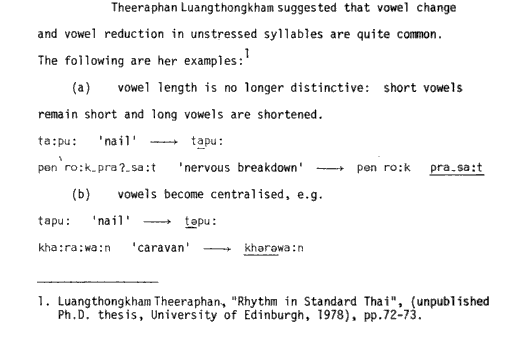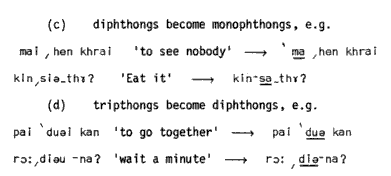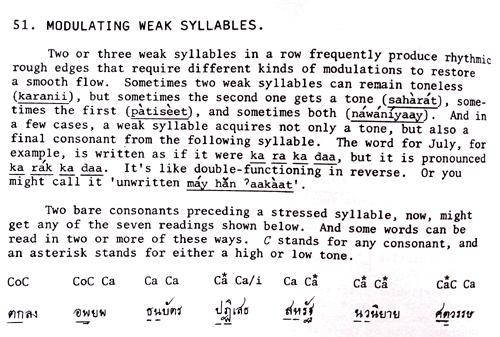I would like to understand more about the phenomenon whereby certain syllables of Thai words, particularly those with sara "a" that are not word-final, get pronounced with a mid tone (or some might say low tone) instead of the tone predicted by the tone rules, e.g. "ma" and "ta" (edited out "ya": it is long) in มหาวิทยาลัย ma-haa-wit-ta-yaa-lai.
For this post, I am specifically not referring to the "irregular tone rule" concerning pairs of spoken syllables where the tone of the second is sometimes determined by the class of the first, e.g. ถนน, เฉลียง, and sometimes by the class of the second, e.g. แสดง, เกษียณ, เฉพาะ. That rule has been studied to quite satisfactory detail on this and other forums, e.g.:
http://www.thai-language.com/id/830221 (part 3d)
Instead, I am referring to cases where a single syllable gets pronounced mid/low, seemingly because it occupies an "unimportant" position at the start or middle of a syllable.
I cautiously refer to these as "unstressed" syllables but I am aware that that is a very dangerous term to use, since "stress" in English is really about inflection and vowel length, and these parameters are already "used up" in Thai to determine the meaning of a word!
I would like to better understand this "unstressed" phenomenon. In particular:
What vowels can it happen to?
- only short ones?
- only sara a?
- only implicit (unwritten) sara a?
- is it even remotely consistent across different Thai speakers?
- is it predictable from the adjacent sounds?
- is it predictable from the adjacent written letters?
- is it predictable from the word's etymology?
- does it ever happen word-final?
- are there any other constraints on where it can happen in a multi-syllabic word?
- does it always make the tone low? mid?
- can it shorten a long vowel?
- are there any other effects it can have?
- a "bad, sloppy" pronunciation ?
- one possible correct pronunciation (another one being the pronunciation predicted by the tone rules) ?
- the only correct pronunciation ?
I am of course open to the possibility that there are several, similar phenomena operating here, and I'd like to understand as many of them as possible!
I figured the esteemed crowd here would already know quite a lot about this subject and be able to give me some info or pointers to info. Up here in Pai in the mountains of Mae Hong Son, I don't have access to any academic libraries, but if anyone happens to have any insights on this, PDF or online papers, books about this that can be ordered (e.g. from Amazon), or emailable scans of relevant papers, it would be greatly appreciated!
Thanks!
- Chris Pirazzi





